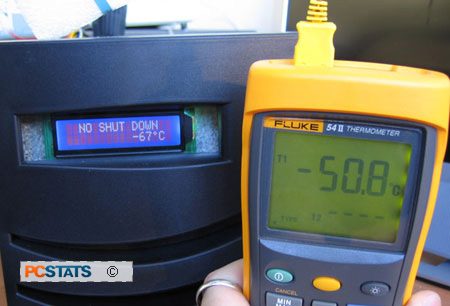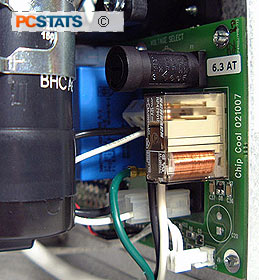The
Prometeia Mach II GT is definitely a product for overclockers at the very
top of their game with conventional cooling technologies, but it is still very
much a luxury product. Still, as good at it is there is some room
for future improvements and revisions here and there. Take
the user manual for starters, it is the old nVENTIV version, and it
needs some working on...
Temperature measurement in computers has always been an
imprecise science. In testing the Mach II GT, we measured
the evaporator temperature
with a Fluke 54-II digital thermometer from the base of the
copper cold head, and compared this figure to the temperature read out on the Mach II GT itself.
The 17°C disparity
we saw prompted us to inquire with ECT about how the Mach II GT takes its temperature readings.

ECT responded with a clarification on where its
internal cold head temperature sensor is located, and what the temperature on the LCD display actually
represents.
The onboard temperature
sensor gets its reading from inside the capillary tubing just before the coolant
goes into the evaporator. There are a couple of reasons for this. First, according to
ECT, that location provides the most accurate reading of the coolant
temperature. Second, this temperature reading helps ensure that the Mach II GT's compressor is running within its operational
range.
While it's understandable why the temperature sensor is placed as such, from
a users perspective the most important value is going to the cold head temperature, as it is
this what interfaces with the processor. Please keep in mind that the
evaporator temperature is not the exact CPU
temperature either. To get that reading,
you must use a separate sensor, either via the motherboard or from a
dedicated thermocouple.
 Short Fuse, Inaccessible
Location
Short Fuse, Inaccessible
Location
In the course
of testing the Prometeia Mach II GT, we managed to blow out a fuse when we
powered on the test system before the cooler's power reset time had elapsed.
Normally when you power the Mach II GT down, it needs a brief period of time (120-180 seconds) before it can safely be
restarted. This is counted down on the front panel display, but we unfortunately ignored
it. The Prometeia also disables the computer case power switch
during this reset countdown, but we used the motherboard's jumper switch
instead. Oops, our fault.
Replacing the fuse proved rather tricky as it is wedged
awkwardly inside the body of the case. We did manage to get it done after a couple of
minutes of struggling with a paper-clip
bent at 90 degrees. According to ECT, fuses of between 6.3A and 8A can be
used. Should you ever need to, the correct size fuse is 20mm long by 5mm
diameter.
Power
Consumption
Considering that this
type of cooling is based on large electrical motor/compressor, it shouldn't come as a
surprise that running the Prometeia Mach II GT will use a lot of electricity.
After all, it's basically a refrigerator. With this in mind, we decided to take some
power readings to see just how much juice the Mach II GT consumes. We connected the Mach II GT to a Seasonic Power Angel,
and here are the results...
When it first starts up,
the Prometeia Mach II GT draws 495W of power. That value quickly drops
to an idle power draw of about 250W.
With an Athlon64
4000+ processor under 100% load, the Prometeia draws slightly more, peaking at the
275W mark.
There's no way around the fact
Prometeia Mach II GT uses a lot of electricity directly; the motor simply requires it.
Comparing the power
usage of the Prometeia Mach II GT to a bar fridge of about 4 cubic feet in
size, we saw similar peak results, as the fridge hit a high of 550W
when first powered on. Normal power consumption was quite a bit lower though, between
70-85W. The Danfoss NF9FX compressor is usually used
in larger appliances like full size fridges, the compressor found in an
average bar fridge is about one-third the size. In any case, it is an interesting comparison.
